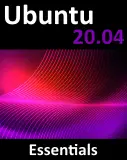Difference between revisions of "About Ubuntu Essentials"
m (Text replacement - "<htmlet>ezoicbottom</htmlet>" to "") |
m (Text replacement - "<table border="0" cellspacing="0">" to "<table border="0" cellspacing="0" width="100%">") |
||
| (One intermediate revision by the same user not shown) | |||
| Line 1: | Line 1: | ||
| − | <table border="0" cellspacing="0"> | + | <table border="0" cellspacing="0" width="100%"> |
<tr> | <tr> | ||
<td width="20%">[[Ubuntu 10.x Essentials|Previous]]<td align="center">[[Ubuntu 10.x Essentials|Table of Contents]]<td width="20%" align="right">[[The History of Ubuntu|Next]]</td> | <td width="20%">[[Ubuntu 10.x Essentials|Previous]]<td align="center">[[Ubuntu 10.x Essentials|Table of Contents]]<td width="20%" align="right">[[The History of Ubuntu|Next]]</td> | ||
| Line 36: | Line 36: | ||
| + | <htmlet>ezoicbottom</htmlet> | ||
<hr> | <hr> | ||
| − | <table border="0" cellspacing="0"> | + | <table border="0" cellspacing="0" width="100%"> |
<tr> | <tr> | ||
<td width="20%">[[Ubuntu 10.x Essentials|Previous]]<td align="center">[[Ubuntu 10.x Essentials|Table of Contents]]<td width="20%" align="right">[[The History of Ubuntu|Next]]</td> | <td width="20%">[[Ubuntu 10.x Essentials|Previous]]<td align="center">[[Ubuntu 10.x Essentials|Table of Contents]]<td width="20%" align="right">[[The History of Ubuntu|Next]]</td> | ||
Latest revision as of 20:04, 27 October 2016
| Previous | Table of Contents | Next |
| Table of Contents | The History of Ubuntu |
Notes from the Author
On October 10, 2010 a company called Canonical Limited officially released Ubuntu 10.10, otherwise known as the Maverick Meerkat release. My journey into the world of Linux and Ubuntu, however, started many years before this latest Ubuntu release.
My first exposure to anything that looked like Linux occurred while providing technical support on a UNIX based system. This was both my first job and my first exposure to an enterprise level operating system. For the first six months I hated the cryptic nature of the UNIX command line tools and woke each weekday morning with a sinking feeling that I was going to once again spend a day battling this operating system. Gradually I began to appreciate the power, flexibility and simplicity of the various components that comprised the UNIX operating system.
In later years I moved into other areas of the IT business and used UNIX less. After relocating across country I found myself faced with setting up a network of systems for a new office and found myself immersed once again in the world of networks and operating systems. I very quickly standardized on Linux as the operating system of choice and equally quickly found myself re-using many of the skills I'd learned from my UNIX days, together with much that is new in Linux (in particular the user friendly graphical desktop environments such as GNOME and KDE).
In order to further broaden my Linux knowledge I decided to attend the monthly local Linux User Group meetings. At these meetings I was humbled by the depth of Linux knowledge of the other attendees and learned more about Linux from these experts than I ever could have hoped for (given that the meetings are held at Red Hat's U.S. headquarters this is hardly surprising).
One month, a member of the user group committee announced that a representative for Ubuntu would be speaking at the next meeting, at which point a loud and sustained cheer rose up from the audience. At this point I had never heard of Ubuntu and had no idea what it was that these experts were so enthusiastic about. All I knew was that if these people thought it was great then I had better find out what it is. I drove home, fired up a web browser and searched for Ubuntu. I quickly found out it was a Linux distribution. How can these people be so excited about "just another Linux distribution"? I had to find out. I slid the Ubuntu Live CD I'd picked up at the meeting into my CDROM tray and booted from it. Several hours later I had my answer. Ubuntu was a nice, easy to use and easy to maintain Linux system. Clearly, a lot of work had gone into making Ubuntu easy to try, install and use, and yet I could still drop down to the low level to perform the more advanced tasks I was used to performing when I needed to.
A few years later I decided it was time to write about Ubuntu and try to give others the chance to find out why Ubuntu is such a popular Linux distribution. It has now been 5 years and this, the latest edition of Ubuntu Essentials, is now complete. I sincerely hope you find this book useful.
About this Book
According to Linux.org, there are over 200 different Linux distributions available. Many of these are actively maintained and have a loyal following, and some less so. Some Linux distributions are quite new and some have been around for a very long time. One Linux distribution that has appeared relatively recently is Ubuntu. Despite being a relative newcomer to the Linux landscape, Ubuntu has very quickly gained prominence in what is clearly a very crowded field. Ubuntu routinely tops the Linux distribution page ranking on DistroWatch.com, and has been selected by Dell and other vendors as the Linux to be pre-installed in select systems. Perhaps the most significant achievement for Ubuntu, however, is that it is popular not just to Linux novices, but also with Linux experts, a group of people known for being highly discerning and critical.
The purpose of this book is to provide an overview of the essential knowledge required to use and maintain an Ubuntu system. From the basics of installation, configuring the desktop and implementing wireless networking through to tasks such as configuring firewalls, setting up a web server, adding disk drives and swap space, configuring KVM based virtualization and providing remote desktop access via an SSH tunnel, Ubuntu Essentials takes a step by step approach to installing, using and administering Ubuntu.
| Previous | Table of Contents | Next |
| Table of Contents | The History of Ubuntu |





